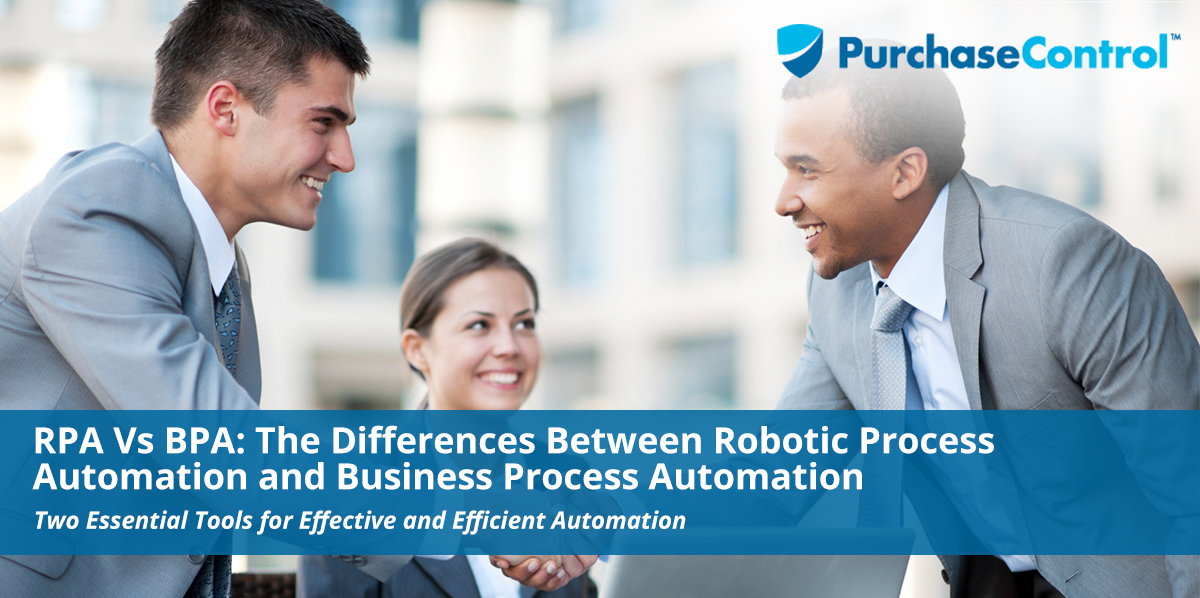As the list of acronyms and initialisms that characterize digital transformation continues to grow, it can be challenging to navigate the “alphabet soup” of terms and technologies. Two complementary technologies that are often conflated (but shouldn’t be) are robotic process automation, or RPA, and business process automation, or BPA. Both of these tech tools can help your business improve its efficiency and productivity, but each has a distinct role to play in the process.
Learning how BPA and RPA work together to streamline your workflows in support of digital transformation can help you put them to effective use in pursuing greater savings, efficiency, and value for your business.
What is Robotic Process Automation?
Applying human time and skills to high-volume, low-value tasks isn’t always the right move for businesses looking to increase their competitive advantage and profitability. Using robotic process automation—the “robot” here refers not to an Asimov-style metal servant, but a software application designed to replicate human behavior—makes much more sense for any repetitive task that’s readily broken down into a series of simple steps that don’t require human insight or intervention.
Software robots can interact with the software environment in the same way humans can in order to tackle specific functions and processes, such as filling out and submitting forms, reviewing email for specific content to generate automated responses, or automatically populating forms with vendor, pricing, and other information. RPA is particularly important to procurement automation, as it can free staff in both procurement and accounts payable from mundane tasks to focus on more strategic endeavors that support the entire business’ goals.
Robotic process automation uses artificial intelligence and machine learning to keep human effort (and error) to a minimum. It can be “taught” over time to refine its own efficiency, and even make contingency-dependent adjustments to ensure workflows are completed, rather than delayed.
Think of RPA as a tactical tool, used to address specific needs within established parameters while replacing less productive manual work.
Some examples of RPA include:
- Data Transfer between Systems.
- Vendor Onboarding
- Customer Order Processing
- Payroll Processing
- Automated Email Review and Reply
- Call Center Routing
- Form Generation
“If RPA is the crew on a busy ship, BPA is the captain, charting a course that ensures the ship not only makes it to its destination, but does so with optimal performance, safety, and cost-effectiveness.”
What is Business Process Automation?
In contrast to the tactical role of RPA tools in effective automation, business process automation is more strategic, providing the overall framework for an organization’s process improvement initiatives.
BPA is not limited to any specific automation technology. Instead, it is an extension of business process management (BPM), which is used to examine, analyze, and streamline business systems to improve efficiency, decision making, and productivity while reducing costs and increasing value.
BPA is characterized by:
- Holistic/Macro-Level Improvements
- Deep and Strategic Analysis of Existing Processes
- Comprehensive Transformation through a Combination of Strategic Planning and Purpose-Built Technological Solutions
If RPA is the crew on a busy ship, BPA is the captain, charting a course that ensures the ship not only makes it to its destination, but does so with optimal performance, safety, and cost-effectiveness. BPA chains together RPA tasks according to a single and complete overarching strategy that supports core business improvements.
The Combined Benefits of RPA and BPA
The benefits that come with automating your workflows are easiest to achieve by implementing RPA as part of a larger BPA-driven strategy.
Let’s say, for example, that your company is implementing digital transformation to shift your manual, paper-based procurement and accounts payable functions to a cloud-based, comprehensive procurement solution like PurchaseControl. Your primary goal is to automate your procure-to-pay (P2P) process, as doing so has strong potential for cost savings and value-building through gains in efficiency and productivity.
The strategic initiative, i.e., “Automate the P2P process,” falls under BPA. Your strategy would likely include:
- Evaluating your existing P2P workflows
- Identifying areas in need of improvement
- Analyzing workflows in those areas and selecting those appropriate for automation.
- Developing a plan, including a timeframe, tools (including software, training, and support), and evaluation mechanism to measure the impact of the changes made through automation.
- Implementing the plan.
- Reviewing the results and making further refinements.
BPA is the big picture. Its purpose is to create a comprehensive plan for improving core processes that affect the entire organization.
RPA enters the scene as you’re automating specific tasks using software tools, such as:
- Purchase Order Creation and Approval
- Receiving Verification
- Invoice Verification and Approval
- Vendor Compliance and Performance Review
RPA is immediate and contextual. Its purpose is to optimize a specific task in support of the goals established by BPA.
With BPA providing guidance and RPA providing specific improvements, your business gains both strategic and tactical benefits from automation. To continue with the P2P automation example, implementing RPA workflows gives you process-specific benefits such as:
- Greater spend data transparency, eliminating rogue spend and fraud.
- Improved collaboration through cloud-based, mobile-friendly access to shared data resources.
- Improved staff morale and productivity through automation of low-value, repetitive tasks.
- Faster, more accurate invoice processing with more captured discounts from early payment.
- Improved inventory management through systems integration.
These improvements, in turn, support larger goals of the BPA initiative, such as:
- A stronger bottom line for the business through increased efficiency and lower costs.
- Improved competitive positioning through more accurate cash flow management and actionable insights gleaned from data analytics.
- More strategic sourcing and better supplier relationships supported by vendor integration with the company’s software environment and the use of vendor management tools to evaluate compliance and performance.
- Implementation of continuous process improvement model across business units and the company as a whole through integration of the procurement solution with existing enterprise resource planning (ERP), customer resource management (CRM), and accounting solutions.
Power up Your Processes with Automation
Investing in process automation can help your company achieve great things, including higher productivity, a stronger bottom line, and the flexibility and agility to crush the competition. By building a winning strategy with BPA, and putting your tech tools to work with RPA, you can improve all your workflows and achieve lasting efficiency and profitability gains for your business.
Automate and streamline your workflows for optimal performance with PurchaseControl.
Find Out How








